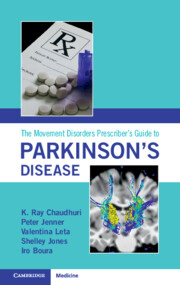Book contents
- The Movement Disorders Prescriber’s Guide to Parkinson’s Disease
- Reviews
- The Movement Disorders Prescriber’s Guide to Parkinson’s Disease
- Copyright page
- Contents
- Foreword
- Abbreviations
- Introduction
- Amantadine
- Amitriptyline
- Apomorphine Hydrochloride Subcutaneous Infusion
- Apomorphine Hydrochloride Subcutaneous Injection
- Apomorphine Hydrochloride Sublingual Film
- Botulinum Toxin
- Citalopram
- Clonazepam
- Clozapine
- Desipramine
- Domperidone
- Donepezil
- Droxidopa
- Entacapone
- Fludrocortisone
- Glycopyrrolate
- Istradefylline
- Levodopa–Benserazide
- Levodopa–Carbidopa
- Levodopa–Carbidopa Intestinal Gel
- Levodopa–Carbidopa–Entacapone Intestinal Gel
- Levodopa, Inhaled
- Lubiprostone
- Macrogol
- Melatonin
- Memantine
- Midodrine
- Mirabegron
- Mirtazapine
- Modafinil
- Naltrexone
- Nortriptyline
- Opicapone
- Oxybutynin
- Pimavanserin
- Piribedil
- Pramipexole*
- Quetiapine
- Rasagiline
- Rivastigmine
- Ropinirole
- Rotigotine
- Safinamide
- Selegiline
- Sildenafil
- Solifenacin
- Tolcapone
- Tolterodine
- Trihexyphenidyl
- Venlafaxine
- Zonisamide
- Levodopa Dose Equivalence in Parkinson’s
- Subcutaneous Foslevodopa Foscarbidopa infusion
- Index
- References
Pramipexole*
Published online by Cambridge University Press: 20 February 2025
- The Movement Disorders Prescriber’s Guide to Parkinson’s Disease
- Reviews
- The Movement Disorders Prescriber’s Guide to Parkinson’s Disease
- Copyright page
- Contents
- Foreword
- Abbreviations
- Introduction
- Amantadine
- Amitriptyline
- Apomorphine Hydrochloride Subcutaneous Infusion
- Apomorphine Hydrochloride Subcutaneous Injection
- Apomorphine Hydrochloride Sublingual Film
- Botulinum Toxin
- Citalopram
- Clonazepam
- Clozapine
- Desipramine
- Domperidone
- Donepezil
- Droxidopa
- Entacapone
- Fludrocortisone
- Glycopyrrolate
- Istradefylline
- Levodopa–Benserazide
- Levodopa–Carbidopa
- Levodopa–Carbidopa Intestinal Gel
- Levodopa–Carbidopa–Entacapone Intestinal Gel
- Levodopa, Inhaled
- Lubiprostone
- Macrogol
- Melatonin
- Memantine
- Midodrine
- Mirabegron
- Mirtazapine
- Modafinil
- Naltrexone
- Nortriptyline
- Opicapone
- Oxybutynin
- Pimavanserin
- Piribedil
- Pramipexole*
- Quetiapine
- Rasagiline
- Rivastigmine
- Ropinirole
- Rotigotine
- Safinamide
- Selegiline
- Sildenafil
- Solifenacin
- Tolcapone
- Tolterodine
- Trihexyphenidyl
- Venlafaxine
- Zonisamide
- Levodopa Dose Equivalence in Parkinson’s
- Subcutaneous Foslevodopa Foscarbidopa infusion
- Index
- References
Summary
Pramipexole ((S)-2-amino-4,5,6,7-tetrahydro-6(propylamino)benzothiazole dihydrochloride monohydrate) is a white to off-white powder, freely soluble in water. It is a dopamine agonist with a molecular weight of 302.3 and an empirical formula of C10H17N3S,2HCl,H2O.
- Type
- Chapter
- Information
- The Movement Disorders Prescriber's Guide to Parkinson's Disease , pp. 363 - 376Publisher: Cambridge University PressPrint publication year: 2025

